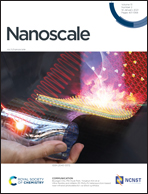First-principles exploration of the versatile configurations at an alkynyl-protected coinage metal(111) interface†
Abstract
Alkynyl groups (R–C![[triple bond, length as m-dash]](https://www.rsc.org/images/entities/char_e002.gif) C–) have attracted intense interest recently as alternative ligands to thiolates to protect atomically precise coinage metal nanoclusters, and more than two dozen compositions have been structurally resolved. However, structure determinations indicated that the interface shows strong metal sensitivity, where a staple motif is the common structural feature at the interface of Au–alkynyl nanoclusters, while the bridging motif dominates at the RC
C–) have attracted intense interest recently as alternative ligands to thiolates to protect atomically precise coinage metal nanoclusters, and more than two dozen compositions have been structurally resolved. However, structure determinations indicated that the interface shows strong metal sensitivity, where a staple motif is the common structural feature at the interface of Au–alkynyl nanoclusters, while the bridging motif dominates at the RC![[triple bond, length as m-dash]](https://www.rsc.org/images/entities/char_e002.gif) C–/Ag and RC
C–/Ag and RC![[triple bond, length as m-dash]](https://www.rsc.org/images/entities/char_e002.gif) C–/Cu interface. To understand their interfacial differences, we employed density functional theory (DFT) calculations to examine the versatile interfacial structures between CH3C
C–/Cu interface. To understand their interfacial differences, we employed density functional theory (DFT) calculations to examine the versatile interfacial structures between CH3C![[triple bond, length as m-dash]](https://www.rsc.org/images/entities/char_e002.gif) C– and the coinage metal surface; both the (111) surface as well as a surface with a metal adatom are investigated. We find that the alkynyl/gold(111) interface does prefer to form the staple motifs, and a linear flat-lying staple motif is preferred. The adatom occupies the bridge position and two CH3C
C– and the coinage metal surface; both the (111) surface as well as a surface with a metal adatom are investigated. We find that the alkynyl/gold(111) interface does prefer to form the staple motifs, and a linear flat-lying staple motif is preferred. The adatom occupies the bridge position and two CH3C![[triple bond, length as m-dash]](https://www.rsc.org/images/entities/char_e002.gif) C– ligands lie diagonally at the fcc hollow sites with the C
C– ligands lie diagonally at the fcc hollow sites with the C![[triple bond, length as m-dash]](https://www.rsc.org/images/entities/char_e002.gif) C bond interacting with the surface Au by both σ- and π-coordination modes. In contrast, the bridging motif is energetically more favored on Ag(111) and Cu(111). The alkynyl carbons form strong σ, π- or σ-only bonds with the surface Ag/Cu, forming μ3-bridge coordination over the fcc hollow site. The binding strengths have the order of Cu(111) > Ag(111) > Au(111). The difference in structural preference is attributed to the intrinsic metal attributes with the different gaps of energetic penalty for surface energy, adatom creation and vacancy formation. The other two reasons are the differences of alkynyl–metal bond character and vdW interaction. We further show that this structure preference is also the preferred bonding mode of CH3C
C bond interacting with the surface Au by both σ- and π-coordination modes. In contrast, the bridging motif is energetically more favored on Ag(111) and Cu(111). The alkynyl carbons form strong σ, π- or σ-only bonds with the surface Ag/Cu, forming μ3-bridge coordination over the fcc hollow site. The binding strengths have the order of Cu(111) > Ag(111) > Au(111). The difference in structural preference is attributed to the intrinsic metal attributes with the different gaps of energetic penalty for surface energy, adatom creation and vacancy formation. The other two reasons are the differences of alkynyl–metal bond character and vdW interaction. We further show that this structure preference is also the preferred bonding mode of CH3C![[triple bond, length as m-dash]](https://www.rsc.org/images/entities/char_e002.gif) C– on M55 clusters and the CH3S–/M(111) interface. Our insights greatly facilitate the structural elucidation and provide useful guidelines for future structure predictions in alkynyl-protected metal nanosystems.
C– on M55 clusters and the CH3S–/M(111) interface. Our insights greatly facilitate the structural elucidation and provide useful guidelines for future structure predictions in alkynyl-protected metal nanosystems.



 Please wait while we load your content...
Please wait while we load your content...